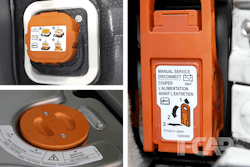Content brought to you by ABRN. To subscribe, click here.
What you'll learn:
- How to access I-CAR best practices and OEM repair information
- Cautions in working with high-voltage systems
- Where to find procedures to disable high-voltage systems before repairs
This is the second in a series of Electric Vehicle (EV)-related articles examining some safety basics. In this article, we lean on I-CAR Best Practices to understand the critical safety considerations associated with a High-Voltage Disconnecting Procedure.
In our initial EV safety article in the September issue, we looked at proper personal protective equipment (PPE). I can’t overstate the need for proper protection – it truly can be a matter of life and death! I now want to follow up with the information and resources you can use to safely disconnect high-voltage systems.
Getting in on this emerging opportunity is an exciting prospect, but enter with your eyes wide open. Without correct knowledge and proper training, an EV repair can be an “accident waiting to happen.” Properly disabling an electric vehicle is critical for personal and shop safety.
RTS portal
One of the most basic steps in an EV repair is locating and understanding the High-Voltage Disconnecting Procedure. In addition to vehicle maker service information, we lean on the industry leading protocols found on I-CAR’s Repairability Technical Support (RTS) portal. I-CAR and subject matter experts from all segments of the industry including vehicle makers, collision repairers, insurers, product makers, and tool and equipment makers work together to develop, update, and publish I-CAR Best Practices.
The recently released I-CAR Best Practice, High-Voltage Disconnecting Procedure, represents the inter-industry-developed-and-vetted best practices to be used when neither vehicle-specific repair information nor OEM-published position statements exist. It’s important to note that this process does not take the place of any OEM procedures or requirements for any OEM specifications of skills, tooling, training, or equipment that enable a repair facility to work on high-voltage (HV) vehicles.
Extreme caution ahead
But more than anything, please approach high-voltage vehicles with extreme caution. Only qualified high-voltage technicians with proper PPE should be permitted to work on the high-voltage system, particularly the components that carry warnings that ignoring the recommended procedures and measures can lead to serious injuries and/or death.
Repair facilities should always reference the documented OEM procedures for specific requirements for the make, model, and year vehicle, before commencing work, to ensure a complete, safe, and quality repair.
This I-CAR Best Practice is modeled after the European regulation ECE-R-100 to ensure that a collision-damaged vehicle is safe, as there is a higher risk of possible damage to the HV safety systems.
The documents within the I-CAR Best Practice for High-Voltage Disconnecting Procedure include:
I-CAR Best Practice - HV Disconnecting Procedure to safely disable and test the vehicle.
I-CAR Best Practice - HV Safety Protocol; a form used to document the inspections and tests.
I-CAR Best Practice - HV Disconnecting Procedure Status Cards which are printable and used to identify the current status of the HV vehicle.
OEM hybrid and electric vehicle disable search
As the collision repair industry prepares for a wave of EVs hitting the road, following OEM repair procedures is critical to repairing hybrid and electric vehicles safely and efficiently.
A useful resource is the OEM Hybrid and Electric Vehicle Disable search on the I-CAR’s RTS Portal. Here you can learn to identify where parts of the hybrid system are located, get instructions for locating the disable procedures in the vehicle maker service information, determine whether a scan tool or other specialty tools and equipment are required to disable the high-voltage system, and, of course the best practices to help ensure a complete, safe, and quality repair.
All that is needed to begin your search is inputting the make, model and/or year for instant disable search results.
Related I-CAR courses
To get your staff trained, I-CAR currently offers seven courses to power up your EV shop repair-readiness. All are offered online and range from 30 minutes to an hour, making it easy to train staff during lunch breaks or downtime. New courses are added regularly.
Powering up your EV knowledge
We understand keeping current on all things EV can be a full-time job. We created a free online resource, Charged for EV, with definitions to help you untangle all of the “EV speak,” to industry -related news and more. Check out it and the list of current EV courses here.



